| | Executive Summary | Introduction | Agronomics | Economics | The Future of Corn in Alberta | Expansion in Similar Regions | Conclusion | Footnotes | Acknowledgements | Review the full report
Executive Summary
In recent years, corn production in Alberta has been expanding, reaching 40,000 seeded acres in 2014. There are several factors underlying this expansion and this report’s intention is to examine these factors, discuss the future potential for this crop in Alberta and make comparisons to the expanding production in other, traditionally non-corn growing areas.
Agronomics
Trends in corn breeding have resulted in varieties which require fewer than 2400 Corn Heat Units (CHU’s) to reach maturity, which makes their production in some southern regions of Alberta possible. Corn crops typically need 500 mm of water per growing season, and since Alberta does not tend to have optimal rainfall in areas with adequate CHU availability, irrigation is necessary for the currently available grain corn varieties.
There are several pests and diseases that can affect corn, so knowledge of control methods and proper crop rotations are very important. Among these, the greatest threat is the increased risk of Fusarium infections. Corn is a host of this pathogen which is capable of causing large economic losses, especially to barley and wheat producers. It is likely that Fusarium will spread with the expansion of corn acres in Alberta.
Producers will need to make some investments in equipment or hire custom work to grow corn. A corn header is required to harvest corn, a row crop planter is recommended for seeding and some drying equipment will likely be needed as well. The cost of this equipment is outlined in the report.
Economics
Cost and Return budget comparisons of grain corn to other irrigated crops in Alberta show that net returns for corn are comparable to alternative crop options. Although it has higher input costs, grain corn also has higher yield potential and thus higher returns, which will likely maintain its appeal to producers despite recent downtrending
market prices.
Grain corn could have an important role in Alberta’s livestock industry as barley acres decrease. For Alberta’s livestock industry to remain competitive, an alternative local feed grain source will be needed. It is expected that the livestock industry will become the primary market for Alberta grain corn production.
Corn is a viable alternative to barley in both ruminant and monogastric diets. It has higher energy values, tends to be more consistent in quality than barley and is the most common U.S. feed grain. Potentially, livestock consumption of corn in Alberta could reach up to 3,620,884 tonnes, assuming 2013 livestock production statistics and corn as the primary feed grain among cattle finishing, pork and poultry diets. There is some ethanol production capacity in Alberta, but it is not expected that ethanol with become a significant use for Alberta’s corn production. The ethanol industry does provide a major source of demand for corn in other regions of North America; however, its upward support on corn prices will likely weaken as ethanol demand has levelled and corn stocks have risen.
Corn in Alberta is often sold directly to the end user, typically a livestock operation. It has some marketing advantages over other crops which include a strong basis and highly liquid futures and options markets, providing producers and buyers with superior risk management options.
The Future of Corn in Alberta
Private investment in corn genetics is starting to focus on developing varieties which require fewer CHU’s (around 1900 to 2000) to reach maturity and have greater drought tolerance. These varieties could expand the areas of grain corn production in Alberta. This would likely include irrigated areas to the west of Lethbridge and Brooks, which receive fewer CHU’s, and higher CHU areas near Edmonton, which would receive adequate rainfall for a more drought-tolerant variety.
There will still be some hurdles to widespread adoption, including costly investment in equipment and a lack of agronomic knowledge. However, industry professionals still expect corn acres to expand into the millions in Alberta. They anticipate a period of producer trial on a small scale until they see consistent and adequate yields, followed by rapid acreage expansion around the year 2020. In regions where both crops can grow, barley will most likely be the crop displaced by grain corn in rotations. These predictions for acreage expansion have been re-enforced by the JBS Lakeside Farm’s experience (near Brooks, Alberta) with recent corn varieties, whose success has led to their acres increasing ten-fold.
Corn Expansion in Similar Regions
Manitoba has recently seen a large increase in corn production, becoming one of the top corn producing areas in Canada. Its upward yield trend and economic competitiveness amongst other cropping alternatives has made it viable option for Manitoba producers.
The corn market in Manitoba has the characteristics of an open, price taker. The price received for Manitoba’s corn crop is largely determined by the U.S. supply and demand situation, and tends to be discounted depending on the dollar exchange and transportation rates. Alberta corn producers will likely face a similar situation of complicated price discovery that is highly influenced by the U.S. However, the feed grain market is much larger in Alberta than in Manitoba.
Montana has recently reached a record-high level of grain corn production in 2013. Grain corn acres as well as yields have been trending upwards for several years in Montana, a region that is also relatively new to corn production, and sees lower yields than many other states. The profit potential of corn has been a large driver behind its expansion in Montana. Corn tends to have higher net profits than wheat or barley, although recent declines in price have caused it to fall behind.
Conclusion
There is much potential for grain corn in Alberta, as it is a competitive cropping option for growers and could serve as an alternative feed grain to barley to supply livestock operations. Grain corn area has grown considerably, increasing 60% in 2014, and it is expected that this trend will continue, with large gains in the next decade. If this expectation is met, we could see more corn in Alberta’s landscape as well as a fundamental shift in livestock feeding practices.
Introduction
Traditionally, grain corn is not a crop produced in Alberta, as its high requirements for heat and moisture made it unsuitable for the local climate. However, the area of grain corn grown in Alberta has been expanding in recent years, reaching 40,000 acres in 2014. This report’s intention is to examine the factors underlying this expansion in Alberta, make comparisons to corn expansion occurring in other traditionally non-corn producing regions and to discuss the potential for this crop in Alberta.
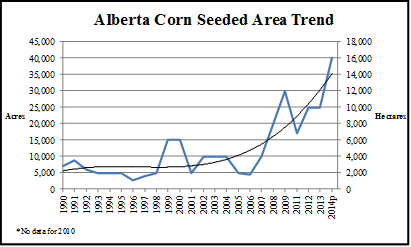
Agronomics
Heat Units
The amount of heat required for corn to reach maturity is measured using Corn Heat Units (CHU’s). CHU’s are an index developed to help producers select the appropriate crop varieties for their region. The daily CHU values for a given area are calculated using the daily minimum and maximum air temperatures and are accumulated over the growing season to determine the total value of available heat units for that area1 .
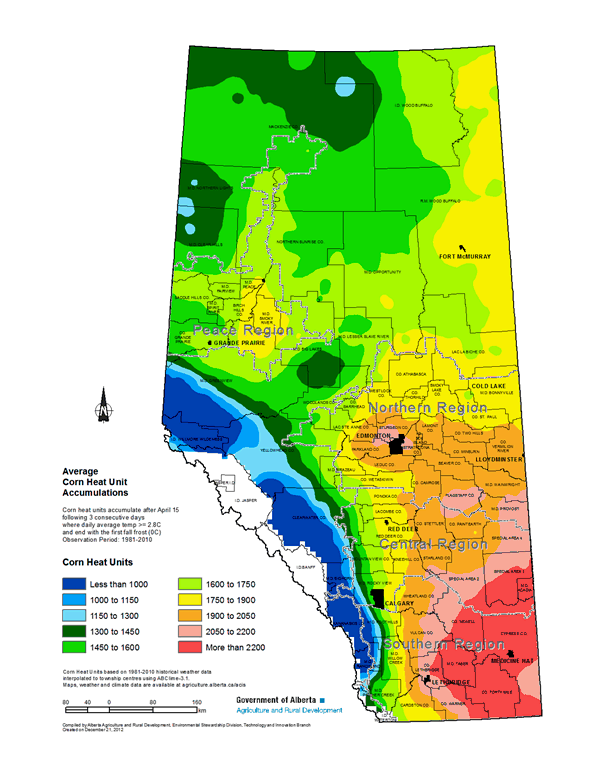
In the last decade, trends in corn breeding have resulted in new varieties that require fewer CHU’s to reach maturity. This has allowed corn to migrate further north into cooler climates making the production of grain corn possible for some areas of Alberta2 .
The following Alberta Corn Committee Grain Performance List for 2013 demonstrates several varieties which offer low CHU ratings and their performance under Alberta conditions.
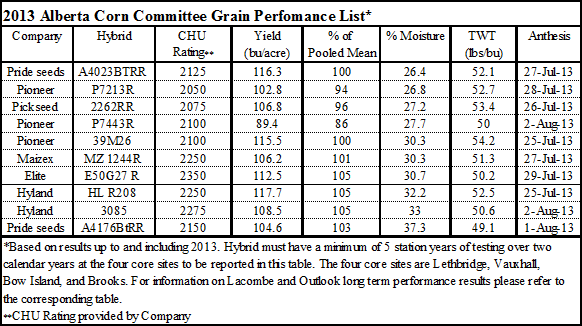
These varieties all have CHU ratings lower than 2400, a rare trait prior to the 1970’s, which allows them to reach maturity in relatively cooler environments. The southern areas of Alberta have the required CHU availability to support the production of these current corn varieties.
Water Requirements
Corn crops typically require approximately 500 mm of water per growing season to reach optimum yield potential3 . However, the average annual precipitation in Alberta tends to fall short of this level, with a particularly large deficit in the areas that have the adequate CHU levels to support corn production. Adequate water is crucial in the development of corn, as soil water depletion levels less than 60% can begin to have negative impacts on yield4 .
To overcome these water deficits, irrigation will be necessary for corn production with current varieties. Alberta already has in place extensive infrastructure for the irrigation of corn. There are currently 1,684,160 acres of irrigation available in Alberta, the majority of which are designated within irrigation districts and the remainder privately held5 . These acres are located in the southern region of the province, most of which receive adequate CHU levels to support corn production. It is in these regions, which receive enough heat and have access to adequate irrigation infrastructure, that grain corn production will most likely be feasible with the currently available varieties
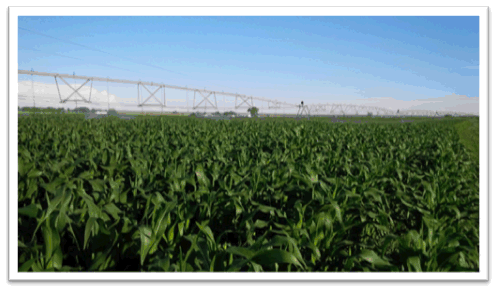
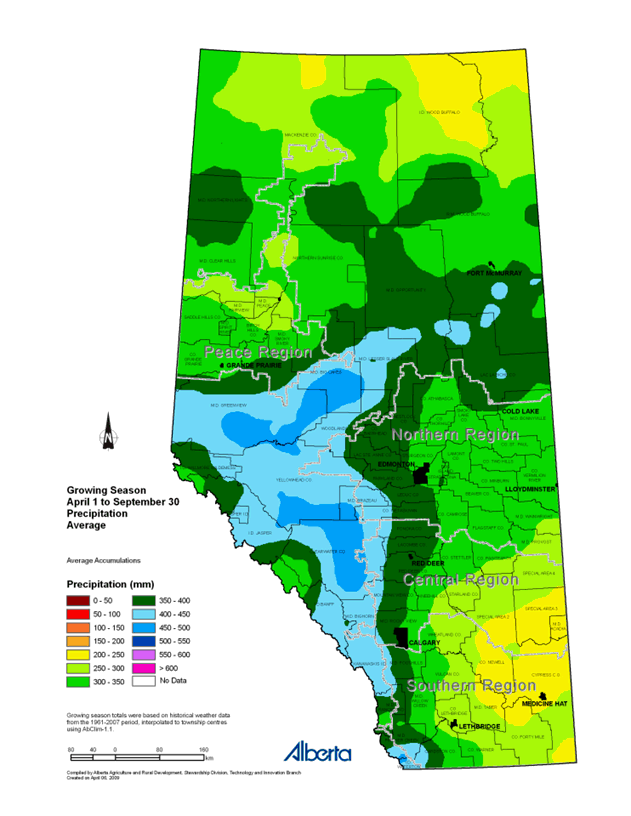
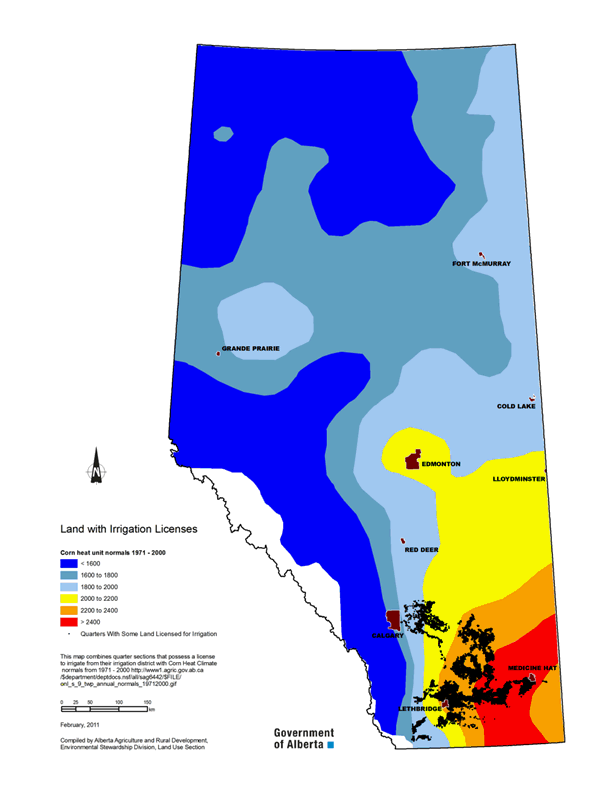
Pests and Disease
Weed competition can be a major cause of yield loss; therefore control of weeds at an early crop stage is a very important agronomic consideration. Several weed species pose a threat to corn crops; the most competitive of these weeds have early germination and large plant architecture. There are several control options available to producers, and most corn varieties employ glyphosate resistant technology.
Insects also pose a threat to corn production, and can result in significant economic losses. In the Northern US Plains, the European corn borer, cutworms, wireworms, white grubs, grasshoppers and corn rootworms are among the most common67 . The use of insecticides, resistant hybrids and strategic crop rotation are the suggested methods of control.
Crop rotations are an especially important consideration for the control of disease with corn. Because corn does not share any diseases with broadleaf crops such as dry bean, soybean, sunflower or canola, alternation of corn with these crops helps break the disease cycle. However, corn does share some diseases with cereal crops that are dominant in Alberta, including wheat, barley and oats.
Fusarium Risk
Fusarium graminearum is a disease of major concern to Alberta, as it has caused millions of dollars in losses annually throughout Manitoba and Saskatchewan over the last 20 years. The pathogen has been present in Alberta in very low levels since 1989; however, it is beginning to increase in incidence and severity. Fusarium poses the greatest threat to central, east-central and irrigated southern Alberta regions. A 2004 assessment of the potential cost of Fusarium to Alberta estimated losses ranging from $3 to $49 million and as high as $64 million, with wheat and barley expected to experience the greatest losses, mainly due to their extensive acreages8 .
The risk of Fusarium discourages the adoption of corn into Alberta crop rotations. Corn is an important host of the Fusarium pathogen, as it survives very well in the residual stalks and roots of corn crops. Therefore, the planting of wheat or barley into ground that previously grew corn results in a high risk of head blight damage losses9. The avoidance of corn in rotations with small grains and continuous or short rotations between hosts are suggested as key methods to limit the impact of Fusarium10.
Although corn is an important host of Fusarium, it is not the crop that will experience the most significant losses. Typically corn experiences infection in the stalks, and unless the ears are affected, reductions in yield and quality are not seen. Small grain crops are impacted to a much greater degree than corn, as the Fusarium pathogen results in both yield and quality reductions. If present in high enough quantities, the Fusarium pathogen can cause mycotoxins that could make the grain toxic to livestock and difficult to sell at all. Therefore, Fusarium is a greater issue for the producers of small grains than corn, as they will experience greater losses from an infection.
Increasing acres of corn will likely result in more Fusarium presence in Alberta crops. Although some prevention is possible for areas of Alberta that are still uninfected, areas which grow cereal crops under irrigation are particularly conducive to the spread of Fusarium. This spread could be further aggravated by the increasing production of corn11.
Machinery
Corn producers have some options when it comes to planting their crops. Row crop planters as well as air seeders can be used to plant corn. However, they are not perfect substitutes for one another. Studies have been conducted which compare the results of planting corn with a row crop planter versus a conventional air seeder. They generally conclude that corn grain yields are higher when a row crop planter is used instead of an air seeder12.
The following rates were taken from the Saskatchewan Farm Machinery Custom and Rental Rate Guide.
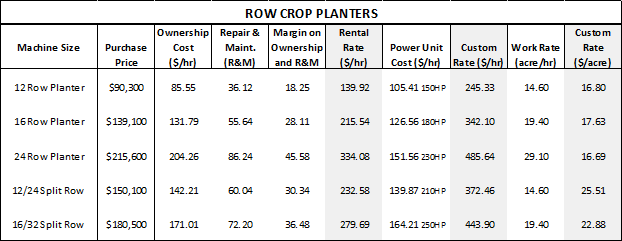
Harvesting corn requires the use of a specific corn head attachment for a combine, and so it is a necessary expense of producing corn.
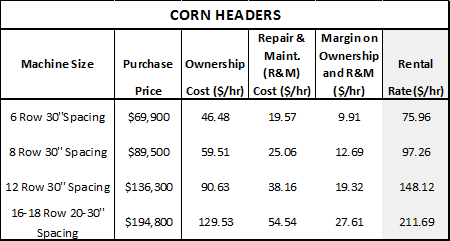
The storage of corn often requires drying it to lower moisture content. According to the North Dakota State University Extension service, corn at moisture contents exceeding 23% should not be stored, as the kernels may freeze or deform and bind together. Aeration to keep corn cool is also crucial, as wet corn can deteriorate rapidly, especially if temperature is increasing. Field drying is noted as one economical method to dry corn in North Dakota until October. However, there are many parameters to consider such as humidity, air temperature, corn maturity and moisture content, solar radiation and wind speed that will impact the effectiveness of field drying. High temperature drying may be necessary to ensure the proper storage of corn13 . The following grain dryer costs were taken from the 2014-15 Saskatchewan Farm Machinery Custom and Rental Rate Guide.
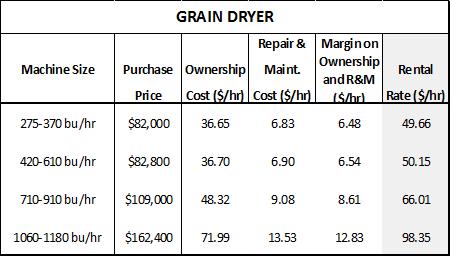
Lastly, residue management is a consideration following production of a corn crop, due to the large production of biomass. In some cases, special tillage tools may be required to effectively manage the trash prior to the seeding of a subsequent crop.
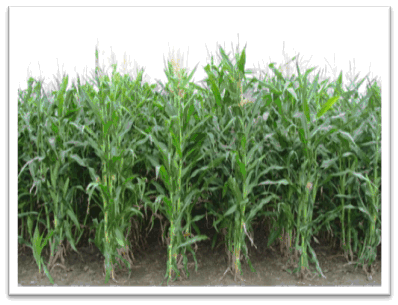
Economics
Cost and Return Comparisons
The following Cost and Return estimations for corn indicate that net returns for corn is comparable to other irrigated cereal crops in Alberta. Corn is a relatively higher input crop, making it more expensive to grow. However, it tends to generate higher revenues, offsetting the greater expenses associated with producing it and creating a return comparable to other cereals. Corn has a greater upside yield potential than its other cereal competitors, also making it more appealing to grain producers facing a down-trending market. Industry professionals expect Alberta producers to continue adopting grain corn, despite the recent decline in price. Growers who consistently meet and exceed yield targets will be the primary adopters.
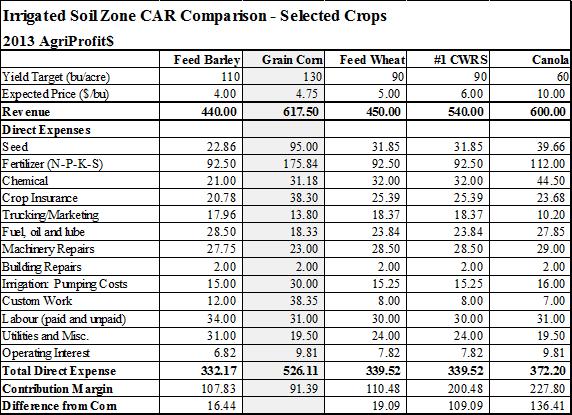
Alberta’s Feed Grain Industry
Barley acres have been trending downwards in Alberta as producers have been gearing their production towards more profitable crop alternatives. This raises an issue for the livestock industry, as historically there been an adequate to surplus supply of feed barley available locally, which may no longer be the case if this trend continues.
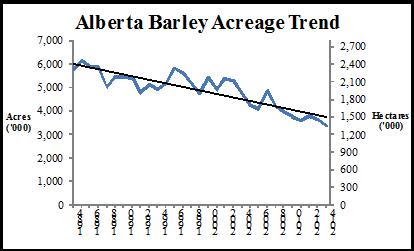
Declining supplies of local feed grains could have implications for the competitiveness of Alberta’s livestock industry. In past occurrences of short local feed grain supplies (during drought years) imports of corn into Alberta dramatically spiked as a result. This demonstrates that when feed grains cannot be sourced locally, livestock producers will go elsewhere. If this trend of reduced local feed grain supplies continues, the competitiveness of Alberta’s livestock industry will likely suffer, as it is not economical to bring in U.S. corn over long distances to feed Alberta livestock.
Therefore, an alternative local feed source may be needed in the future to maintain the growth and competitiveness of Alberta’s livestock industries. This is where corn production in Alberta could fit. There is already a local demand for this crop, and it is expected that the livestock industry would become the primary market for Alberta’s corn production.
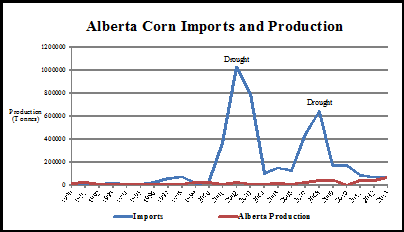
Corn V.S. Barley
Corn is the most common feed grain throughout the U.S., and is growing in popularity among the northern states as its production moves north. It can be substituted relatively easily for other feed grains and contains slightly higher energy content, although some supplementation for protein and other nutrients will likely be needed. Corn also has the benefit of remaining fairly consistent in nutrient quality among different harvesting, storage and processing conditions. This gives it an advantage over barley, which can have considerable variations in energy and protein content.
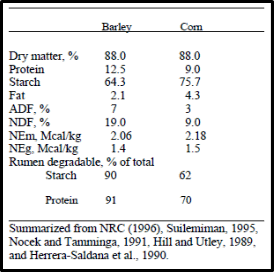
Feeding Ruminants
Corn is a feed grain that can be used in many different types of beef cow diets and serve as the sole grain source in back grounding and finishing diets. Frost damaged corn can still be utilized for feed without a great reduction in feeding value, an important consideration in our colder climate14. In terms of nutrition, corn is a formidable competitor to the conventional feed grains used in Alberta. Considering the differences in protein and the cost to supplement it, corn carries approximately 98% of the value that barley does. However, corn does has the advantage of being higher energy (5-10% higher) than barley. Generally, cattle fed corn may have higher intakes, slightly higher gains, but no significant advantage in efficiency over barley.
Although corn can substitute for barley in ruminant diets, it is not a costless switch. The cost of protein supplementation needs to be taken under consideration when comparing corn to barley. A rough rule of thumb suggests that a 1% increase in protein from urea in the supplement will cost $1.20 per tonne. For example, increasing protein from 10 to 20% will cost around $12 per tonne. Processing is also generally needed to capitalize on higher energy values (by steam flaking or fermenting), which is something that most Alberta feedlots are not set up to do15 . Alberta feeding operations must overcome some of these barriers before widespread adoption of corn will be seen.
Feeding Monogastrics
Throughout the U.S., corn is also the major feed grain used in swine production. It is an excellent source of energy for monogastrics, but lacks in protein, minerals and vitamins and so it must be properly supplemented. The following summary from the University of Kentucky compares the responses of growing-finishing pigs fed grain based diets (supplemented with soybean meal, vitamins and minerals)16 .
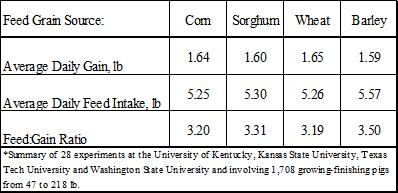
In Alberta, most swine diets are formulated using a combination of barley and wheat, as barley alone does not contain adequate energy. Corn could substitute for these grains, as is the case in Manitoba, where more corn has been fed to swine as availability has increased.
In the poultry feed market, there are two dominating grains; wheat and corn. This is because they can be used interchangeably to achieve equal performance in poultry production. However, their substitution for one another is not one-for-one. Generally the use of wheat instead of corn requires addition of liquid fat and higher enzyme supplementation, to aid in the tougher digestion of wheat. Clearly, the potential exists for corn to overtake wheat in the Western Canada poultry feed market, as the two grains are generally considered substitutes of one another17 .
Meat Quality
Feeding livestock corn instead of barley has little effect on the quality of their meat. Studies that compare meat characteristics of corn to barley fed beef have generally found that there is little difference between the two grains in terms of their effect on carcass quality, tenderness and taste. The only difference found is a lighter meat color that results from barley as the main grain source in the finishing diet18 . Similar results have been observed in pork trials that compare barley to corn based diets. In these trials, it was also found that diet made little difference in meat quality traits. However, it was observed that the barley fed hogs had firmer fat than those fed corn19 .
Consumer Preference
Despite the few differences between barley and corn fed meat quality, there are some implications for consumer preferences. A 2008 study that examined consumer preferences for barley or corn fed beef made some interesting observations. They found that the Canadian panelists (in this study majority were Alberta residents) had a significant preference for the overall taste and appearance of barley-fed steaks. This finding is supported by the tendency for consumers to prefer foods that they are familiar with. The Japanese panelists preferred the appearance of the barley fed steak with its white fat, as the highly valued local beef in Japan tends to have lighter fat and lots of marbling. This preference is also observed in the Japanese pork market, where consumers also tend to prefer firmer meat with white fat. However, in this study the Mexican consumers and the trained panelists had no significant preference for either steak. Instrumental evaluation further indicated that there was very little difference between the corn fed and barley fed beef samples20 21 .
It has been well documented that feeding corn or barley results in meat of similar quality. However this study, as well as other market observations, indicates that in spite of the similarities there remains some consumer preference for barley fed meat, primarily based on the appearance of it. Therefore, the incorporation of corn into Alberta’s feeding operations could have some implications for the marketing of Alberta meat products to some regions.
Potential Feed Industry Corn Consumption
Currently, corn is not the primary source of feed for Alberta livestock operations. However, it is the most widely used grain in the U.S., and the potential exists for it to become the primary feed grain in Alberta as local corn production increases. The following estimates of potential livestock consumption in Alberta were made by estimating the proportion of corn present in a corn-based diet (species specific), estimating the total per-animal consumption of grain corn and multiplying that value by the total number of animals produced in 2013. Two thirds of Alberta’s feed consumption is by beef feedlots, followed in order of size by the pork, dairy, and poultry sectors. Total potential corn consumption was estimated at 3.6 million tonnes. This gives an idea of the potential demand for corn from Alberta livestock operations, assuming no significant change in the size of Alberta’s livestock industry in coming years.
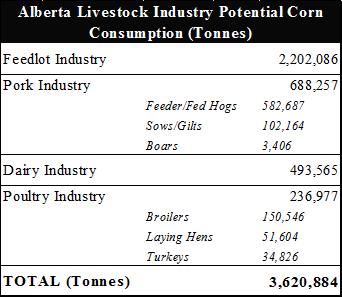
Given Alberta’s 2013 average yield of 8.1 tonne/ha, to supply this quantity of corn to the livestock industry approximately 447,023 hectares (1,104,146 acres) of corn production would be required. For the 2014 crop year, there are 16,200 hectares (40,014 acres) of corn planted. Although this is a significant increase from 2013, it is still an order of magnitude (ten-fold) smaller than what is required to feed all of Alberta’s livestock industry.
Ethanol Industry
Canadian Production
Current production capacity of Canadian ethanol is at 240 million litres per year, which is only 3% of U.S. ethanol production. Almost 80% of feedstock used in Canada is corn, with the remainder largely made up of wheat. However, several of the newer plants which process wheat have the flexibility to process corn as well. For example, the Husky Energy plant in Manitoba switches to corn when wheat feedstock becomes too expensive22 .
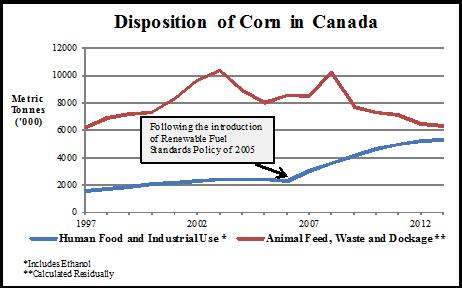
Western Canadian Production
Of the total ethanol production capacity in Canada, only 20% is available in the Prairie Provinces. Alberta is the home of 2 operational ethanol plants; Permolex International L.P. in Red Deer, with a capacity of 42 million litres, processing wheat, corn, barley, rye and triticale, and Growing Power Hairy Hill, with a capacity of 40 million litres, processing wheat23 . Neither plant is in a large current or potential corn producing area. Therefore, although there is some ethanol production in Alberta, it is unlikely that it will become a primary market for Alberta corn.
However, ethanol production does have some implications for the price of corn that Alberta producers receive. Ethanol has become a large source of demand for corn since the introduction of Renewable Fuels Standard Policy in the U.S. and similar policies in Canada. Some estimates indicate that for every billion gallons of ethanol production (above the threshold quantity of 4 billion) a corn price increase of $0.20 per bushel results. For all stocks-to-use ratios, the prices for corn were significantly higher after the introduction of the biofuel policy than prior relationships indicated. This provided a significant incentive in the past decade to increase corn acres and develop higher yielding varieties24 .
However, the U.S. Environmental Protection Agency has since proposed the reduction of gasoline blending requirements of ethanol for 2014. This policy change in combination with increasing corn stocks could dampen the effect of ethanol’s upward support for corn prices25 .
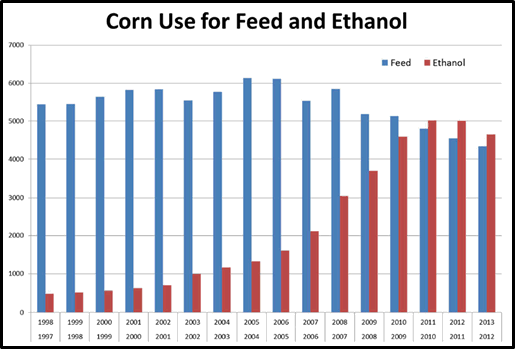
Marketing
In Alberta, corn is often marketed directly to the end user, which is typically a feedlot or an intensive livestock producer within easy driving distance. Local feed mills and feed brokers are also frequent buyers. Because of the relatively low domestic production, low transportation costs, and strong demand in regions where corn is currently grown, basis has typically been strong in comparison to many other crops, frequently positive to futures. Another marketing advantage is that the corn futures and options market is highly liquid, facilitating risk management. However, the exchange rate must also be taken into consideration. In some regions, local feeders have offered forward contracts for regular or high moisture corn, with price determined in advance. Typically, corn is marketed as a cash crop in Alberta, with limited on farm storage. An important marketing distinction compared to other cereals is that corn is grown specifically for the purposes of feeding to livestock, while for other cereals the livestock feeder is often the buyer of last resort.
The Future of Corn in Alberta
Upcoming Varieties
Private companies are beginning to invest in corn genetics that will allow for the expansion of corn into more regions of Alberta. The primary focus for these companies is to develop new varieties that mature within the cooler and shorter Western Canadian growing season. Currently varieties that will mature at 2100 Corn Heat Units are available. However, breeding efforts are being directed at getting maturity ranges down to around 2000 or even 1900 CHU’s, with varieties that contain such genetics currently undergoing testing. In the next 5 years, these earlier maturing varieties should become available to producers. The other major focus of corn breeding is reducing the moisture requirement. There are currently drought tolerant varieties available in the western United States; however, these varieties have CHU requirements too high for the Canadian Prairies to support their production. These traits will likely be making their way into earlier maturing varieties, with some drought tolerant traits already being tested. This means that corn acres could expand beyond irrigated acres and migrate into dry land production, but the timeline on such a shift is unknown at this point. Historically in other regions, as yields consistently reach 110 bushels per acre, the adoption rate of corn increases more rapidly. The introduction of both early maturing and drought tolerant varieties that meet key yield thresholds could open up more area of agricultural land for corn production in Alberta.
Investing in the Future of Corn: DuPont Pioneer’s Lethbridge Research Facility.
In the summer of 2014, DuPont Pioneer began the construction of a multi-million dollar research facility located near Lethbridge, Alberta. The primary focus of this facility will be the development of ultra-early maturity corn hybrids and increased drought stress tolerance. Lethbridge was chosen as it allows access to higher and lower CHU areas as well as the option of irrigation or dry land.
DuPont Pioneer sees corn as a high value option for growers in Western Canada. Their most optimistic outlook suggests that corn acres could reach 10 million in Western Canada around 2025. They already have research facilities in Southern Manitoba, but they want to develop hybrids more suited to Alberta and Saskatchewan. In the future, this facility may also work with other crops such as soybeans and canola. It is expected to be complete by the end of 2014.
Source: Steven King, Corn Research Director, DuPont Pioneer, Personal Communication |
Potential Areas for Expansion
The following map outlines potential areas for corn expansion in Alberta, given the expected varieties are released in the future. A large portion of the province is already highly suitable to corn production, having adequate heat units and irrigation available to grow current varieties. Pending the release of lower heat unit varieties, the region indicated by blue could see corn production in the future since it has irrigation available, but not enough heat for current varieties. The area indicated by yellow in the northern region could also see corn production should drought resistant varieties become available in the future. This area has adequate heat units to support current varieties, but lacks irrigation and adequate rainfall. Similarly, the large area in purple would have sufficient heat units for existing or new expected varieties, but in most cases would require supplemental water to produce a crop. Applied research employing the new varieties will determine the true potential for corn in much of the province.
It is unlikely that grain corn acres will significantly expand along the western growing areas and the central Highway 2 corridor of Alberta, even after the hybrids currently under development are released. Being closer to the Rocky Mountain range, western regions of Alberta are limited by cooler night temperatures. Corn is a ‘C4’ plant, which means it uses carbon from the atmosphere more efficiently than the ‘C3’ plants that are commonly grown in Alberta. C4 plants carry out many of their metabolic functions in the evening, which require temperatures of 10�C or higher. Consequently, it is difficult to breed a ‘cool night tolerant’ corn variety and maintain high productivity.
Investing in the Future of Corn: Monsanto’s Corn and Soybean Expansion Project.
Monsanto officially announced its commitment to expanding corn in June of 2013. The company has committed $100 million dollars over 10 years to invest in breeding and research work. Included in this investment are 3 new technology trait development sites. A new corn breeding and testing station has also been added at Carmen, Manitoba, with more stations scheduled to open up near Winnipeg, Regina and Lethbridge in the coming years.
In addition to these infrastructure investments, Monsanto is also working to develop agronomic knowledge. They are investing in hiring new trait development representatives, additional agronomists as well as training events such as ‘Seed University’ to enhance agronomic knowledge available to producers.
Their focus is on breeding corn hybrids with earlier relative maturities that are adapted to the climate of Western Canada.
Source: Dan Wright, Monsanto, Personal Communication |
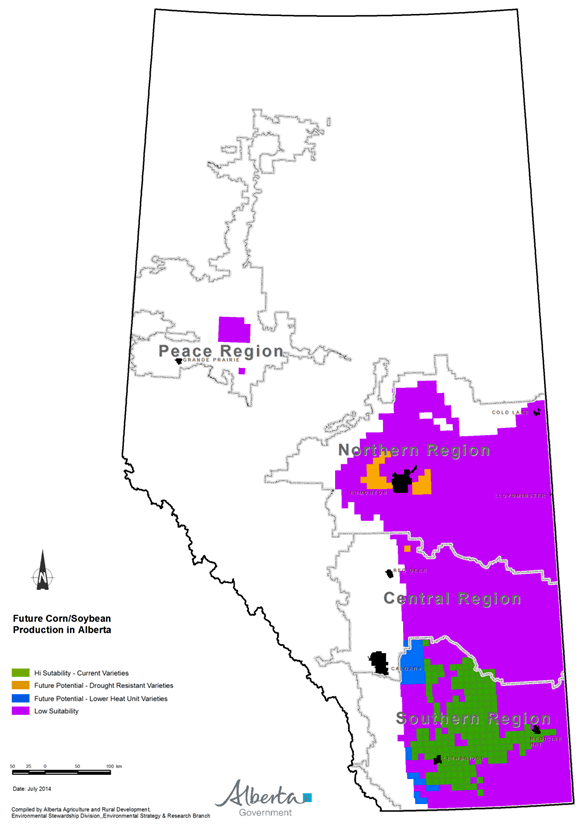
Hurdles to Adoption
There are a few key challenges to the adoption and widespread expansion of corn in Alberta. First of all, producers will likely need to make a considerable investment in new equipment. Corn is a crop that must be seeded properly in order for it to reach its full potential, a job which should be done with a row crop planter. Harvesting corn also requires the use of a specific corn header, and often drying equipment will be needed as well to ensure proper storage moisture. Adequate labour was also mentioned as potential issue for producers. Corn yields approximately four times as much product as some other crops, and so more labour will be required to move that larger volume of grain. Agronomic knowledge is another possible hurdle for corn adoption. This crop is relatively new to the Canadian Prairies, and so producers face a lack of knowledge and experience growing it, which could slow down the rate of adoption. However, corn is a competitive option for rotations, and industry professionals expect producers will make it work despite the challenges of adoption that it presents.
Predictions for Expansion
Industry professionals predict large gains in corn acres to be seen in Alberta. Following the introduction of earlier maturing varieties, they anticipate a trial period where producers try corn on a small scale. In these five or six trial years, producers will experiment with corn until they see consistent yields and have positive experiences growing the crop. After this trial period (around the year 2020), corn acres are predicted to expand rapidly. Some expect to see corn acreage expand into the millions. With this expansion, it is predicted that the other cereals (barley in particular) will be taken out of production to make room for the more profitable corn crops, as this is the trend that was seen in Manitoba and the Dakotas when corn made its expansion there. Corn is a desirable crop for producers; it is profitable and provides more options for their rotations, and with the advances in corn genetics it will become an increasingly attractive option for Alberta26 27 .
Corn in Alberta – the JBS Lakeside Experience
The JBS Lakeside farm, located near Brooks Alberta, has historically grown around 400 acres of corn. Much like the rest of Alberta, the number of acres allocated to corn was limited by the lack of suitable seed varieties. However, in the last 12 years, their corn acres have increased greatly, reaching 4,000 in 2014. This growth has been facilitated by the introduction of corn varieties that are better suited to Alberta’s climate. These new varieties have led to increased yield and reduced production risks, making corn a more viable option for JBS Lakeside.
Corn is gaining importance in the JBS Lakeside feedlot, as the company has made plans to increase the level of grain corn in their rations to 20%. This shift translates into approximately 25,000 acres of corn production required, most of which will be locally sourced. Although Alberta feedlots traditionally feed barley, JBS is transitioning its feeding towards corn. Corn has the advantage of higher energy digestibility which means better performance in the feedlot.
In 2013, JBS Lakeside experienced an average corn yield of 178 bushels per acre, considerably larger than the 129 bushel per acre provincial average (Statistics Canada). This above-average yield was attributed to good management practices. Field selection, variety selection and chemical application were cited as some of the key management considerations. The use of a row planter was also recommended, as seed spacing is very important for corn to reach its potential.
Corn has become an integral part of the JBS Lakeside farm, taking over approximately half of the farm’s acres. It’s valuable to the company’s feeding operations, and is beginning to compete with barley for share in rations. JBS Lakeside has had a positive experience with corn, and it will continue producing corn for years to come.
Source: Pat Gummeson, JBS Lakeside Farm, personal communication
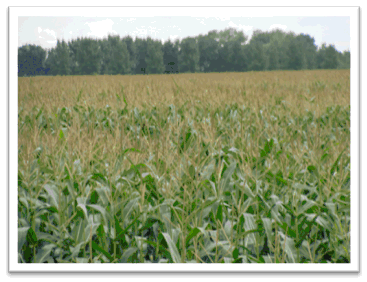
JBS Lakeside Corn Field near Brooks, Alberta |
Expansion in Similar Regions
Manitoba
Like Alberta, the production of grain corn in Manitoba has been dependent on the development of better suited varieties. The rapid increase of corn acres in Manitoba is a result of these new varieties and their improved yield potential, as well as the rising demand for corn from the livestock and ethanol industries. Manitoba is now among the top grain producing provinces in Canada28 .
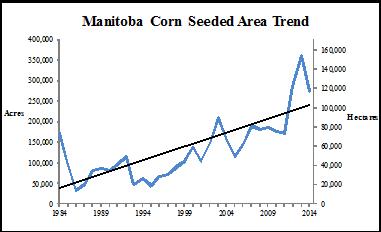
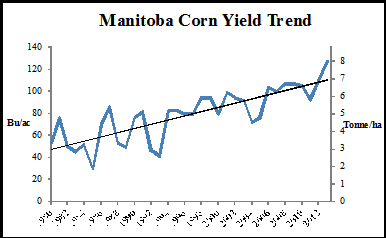
The average yield in Manitoba has been increasing over the last 3 decades. Figure 19 shows an upward trend in the yields experienced by Manitoba producers. Corn is also an economically competitive crop amongst the options available to Manitoban producers. Figure 20 shows a direct comparison of the returns over operating costs between common crops. Despite its recent decline in prices, corn remains a competitive option amongst Manitoba crops. This is also a factor which has contributed to the expansion of corn in Manitoba.
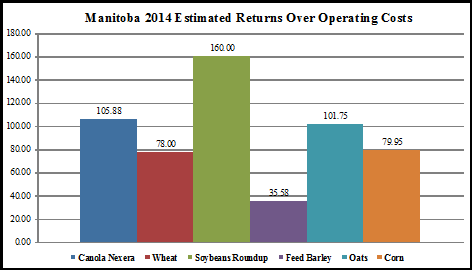
Market Structure and Price Discovery
Relative to the global corn market, Manitoba is a very small player, making them an open market price taker. Due to the large size of the U.S. corn market as well as the ease of substitutability between the two nations’ grain corn crops, the price received by Manitoba producers is mainly determined by the supply and demand situation facing the US. Therefore, demand factors affecting Manitoba (along with the rest of Western Canada) will have a relatively small impact on the local price received. In terms of supply, the U.S. corn price will also be used to determine expected return and has a significant effect on the allocation of farm land between cropping options.
However, the price of corn in the U.S. may not be fully realized by Western Canadian producers. A number of factors play into the spread between Chicago Board of Trade prices and the actual cash price received up here. Among the most important of these factors are the dollar exchange rate between Canada and the U.S., transportation costs and local demand.
Grain corn prices in Alberta will also be complicated to determine. Being an open, relatively small market in comparison to the U.S. means that our corn price will be largely dictated by foreign supply and demand factors as well as the dollar exchange and transport rates. The substitutability of feed grains will result in greater demand fluctuations from the livestock sector as relative prices change. Also influencing these fluctuations is the ability for suppliers to reallocate their land to higher value crops as well. Therefore, factors affecting both local as well as global supply and demand will have significant effects on the price received by Albertan producers29 .
Montana
Much like Alberta, Montana is not traditionally a corn producing region. However, recently they have been experiencing increased production of grain corn, reaching record high levels in 2013. Montana serves as a useful platform for comparison to our situation north of the border. They share several climatic similarities as a result of their close geographical proximity, and therefore face many of the same issues as Alberta in terms of corn production.
Montana corn acres (including grain and silage) have overall increased in the last decade. Much of this growth is coming from increases in grain corn acres. As is shown in Figure 21, the number of silage corn acres has slightly decreased as the number of grain corn acres has increased30 .
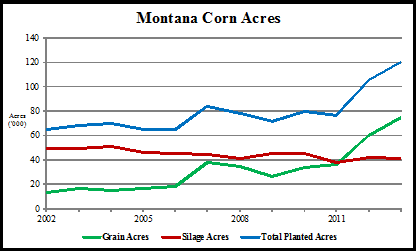
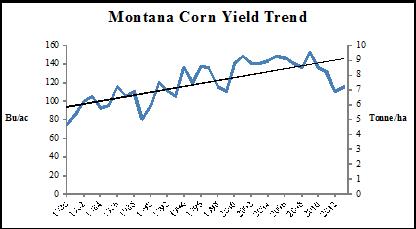
The drivers behind the growth of corn adoption in Montana are very similar to that of Alberta. Recent introductions of varieties which tolerate cooler weather and less moisture have made the production of corn possible in the Montana climate. Corn also offers more rotation options to producers, being especially appealing to sugar beet growers31 . These agronomic advantages coupled with recently high prices have led to increased corn production in Montana32 .
Profitability - Cost and Return Comparisons
The profit opportunities associated with the production of corn have been a large driver behind its adoption in Montana. This state belongs to the Northern Great Plains region of the U.S. (the region which would most closely resemble the Canadian Prairies), and as the following graphs show, the profitability for grain corn in this region generally tends to be lower than the national average, commensurate with lower average yields compared to other regions. These values are represented in U.S. dollars, and exclude government payments.
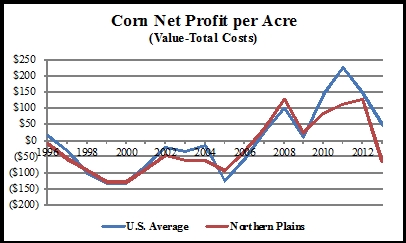
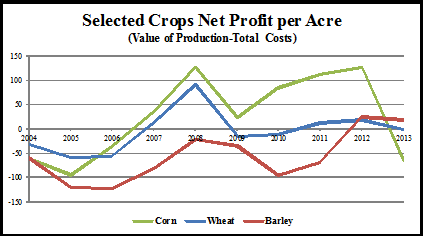
CONCLUSION
Grain corn could still be considered a specialty crop in Alberta, although area has grown considerably, increasing 60% in 2014 to reach 40,000 acres. Much of this gain in acreage can be attributed to breeding efforts which have resulted in corn that can mature in Alberta’s cooler environment. Looking at the experience of neighbouring states and provinces, further acreage increases are anticipated, as varieties which consistently reach key yield thresholds in our growing conditions become available.
Producers must take under consideration several agronomic issues before incorporating corn into their rotations. Heat and moisture requirements are the greatest limiting factors to its production, so with the currently available varieties corn adoption is largely constrained by geography. Disease risks, especially Fusarium risk, are another hurdle to adoption, as it poses a large threat to the small cereal grains. The investment requirements in machinery also present a hurdle to adoption, as producers will likely need to purchase or rent specialized equipment.
Despite the agronomic challenges, corn is still an attractive cropping choice that gives growers more rotation options. Cost and return comparisons of corn to other crops under irrigated conditions in Alberta shows that, despite the recent down-trend in its price, corn remains economically competitive. Corn also has the advantage of greater upside yield potential, which adds to its appeal as a crop. Therefore, it is expected that producers will continue adopting corn even if lower pricing prevails. Thanks to the large investment of private sector crop breeders in Western Canada, farmers can fully anticipate new varieties available on a regular basis.
The livestock industry in Alberta also stands to gain from growth in local corn production. Barley acres and therefore local feed supplies have been on the decline for many years. Historic import data shows that livestock producers import U.S. corn when a local feed grain shortage occurs. Since it is not economical to import grain over long distances, the competitiveness of Alberta’s feeding industry could suffer if an alternative feed grain source is not adopted. Due to this fact, it is expected that the livestock industry will become the primary market for Alberta’s corn production. Estimates indicate that potential consumption of grain corn could reach 3.6 million tonnes annually in Alberta. This would consume the production of approximately 447,000 hectares (1.1 million acres) of corn in Alberta, assuming current yield average of 8.1 tonne per hectare.
Grain corn has a promising future in Alberta. Private breeding companies have begun to make significant investments in developing varieties that are better suited to Alberta’s climate, which will open up more acres to grain corn production. Industry professionals anticipate large gains in the next decade following the introduction of the next generation of varieties. If their expectations are met, we could see more corn in Alberta’s landscape, as well as a fundamental shift in Alberta’s livestock feeding practices.
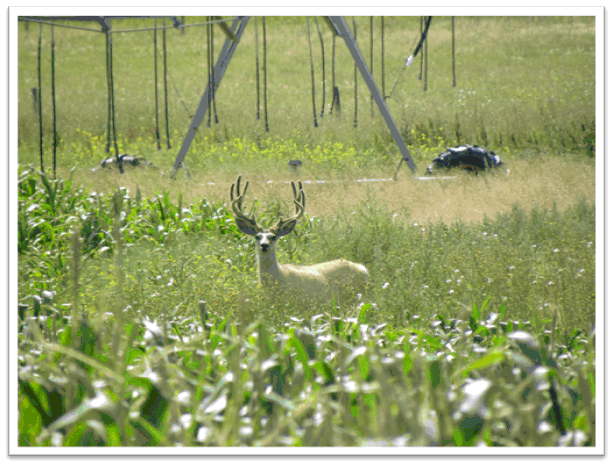
Footnotes
1 Brown, D.M. and A. Bootsma. 2005. “Crop Heat Units for Corn and Other Warm Season Crops in Ontario”. Ontario Ministry of Agriculture Food and Rural Affairs. http://www.omafra.gov.on.ca/english/crops/facts/93-119.htm
2 Baron, V.S., O. Masahito and A. Aasen. 2008. “Challenges for Growing Corn Silage Suitable for the Dairy Industry in a Northern Climate”. WCDS Advances in Dairy Technology 20: 181-192
3 Saskatchewan Ministry of Agriculture. 2010. “Corn Production”. http://www.agriculture.gov.sk.ca/irrigation
4 Efetha, Alan. 2012. “Irrigation Scheduling for Silage Corn in Southern Alberta”. Alberta Agriculture and Rural Development. http://www1.agric.gov.ab.ca/$department/deptdocs.nsf/all/agdex14256
5 Alberta Agriculture and Rural Development. 2012. Alberta Irrigation Irrigation: Facts and Figures for the Year 2012. Government of Alberta, Basin Water Management Branch and Irrigation and Farm Water Division. http://www.agric.gov.ab.ca
6 Ransom, Joel, et al. 2004. “Basics of Corn Production in North Dakota”. NSDU Extension Service. http://www.ag.ndsu.edu/crops/corn
7 USDA National Institute of Food and Agriculture. 2002. “Crop Profile for Corn in Montana”. http://www.ipmcenters.org/cropprofiles/GetCropProfiles.cfm
8 Alberta Fusarium Action Committee. 2012. “Alberta Fusarium graminearum Management Plan”. Government of Alberta. http://www1.agric.gov.ab.ca/$department/deptdocs.nsf/all/agdex5210
9 Ransom, Joel, et al. 2004. “Basics of Corn Production in North Dakota”. NSDU Extension Service. http://www.ag.ndsu.edu/crops/corn
10 Alberta Fusarium Action Committee. 2012. “Alberta Fusarium graminearum Management Plan”. Government of Alberta. http://www1.agric.gov.ab.ca/$department/deptdocs.nsf/all/agdex5210
11 Personal Communication, Michael Harding, AARD Crop Research and Extension Division
12 Albus, W., L. Besemann and H. Eslinger. 2008. “Shank-Till Air Drill vs. Row Crop Planter in Corn”. NDSU Carrington Research Extension Center. http://www.ag.ndsu.edu/CarringtonREC/agronomy/production-management?b_start:int=60 and Weidong, L., M. Tollenaar, G. Stewart and W. Deen. 2004. “Impact of Planter Type, Planting Speed and Tillage on Stand Uniformity and Yield of Corn”. Agronomy Journal. 96:1668-1672.
13 Hellevang, K. 2011. Corn Drying and Storage Tips for 2011. NDSU Extension Service. Retrieved from: http://www.ag.ndsu.edu/graindrying/corn-and-soybean-page
14 Lardy, Greg. 2013. “Feeding Corn to Beef Cattle”. NDSU Extension Service. http://www.ag.ndsu.edu/publications/livestock/beef .
15 Gibb, D.J. and T.A. McAllister. “Corn compared to barley in feedlot diets”. Agriculture and Agri-food Canada. http://www.balancedbeef.com/articles.php
16 Cromwell, G.L. “Corn-Is it Still the Best Feed Grain for Swine?”. University of Kentucky. http://www.uky.edu/Ag/AnimalSciences/pubs/cornisitstillthebestfeedgrainforswine.pdf
17 Bolden, S. “Achieving great broiler results with corn or wheat diets”. Cobb Academy. http://www.cobb-vantress.com/products/overview/blog/-in-category/categories/nutrition
18 Oliveros, M.C.R, K.M. Park, E.G. Kwon, N.J. Choi, J.S. Chang and I.H. Hwang. 2009.“Carcass Traits and the Quality of Meat from Cattle Finished on Diets Containing Barley”. The Asian-Australian Journal of Animal Science. Vol, 22, No. 11, 1594-1608. http://www.ajas.info/journal/view.php?number=22195
19 Lampe, J.F., J.W. Mabry and P.J. Holden. (2004) “Comparison of Grain Sources (Barley, White Corn, and Yellow Corn) for Swine Diets and Their Effects on Meat Quality and Production Traits” Animal Industry Report: AS 650, ASL R1954. http://journalofanimalscience.org/content/84/4/1022.full
20 Wismer, W.V., E.K. Okine, A. Stein, M.R. Seibel and L.A. Goonewardene. (2008) “Physical and sensory characteriszaition and consumer preference of corn and barley-fed beef”. Meat Science. Vol. 80 Iss 3. Pg. 857-863. http://www.ncbi.nlm.nih.gov/pubmed/22063608
21 Makise, K. (2002). “Maintaining and Expanding Pork Export to Japan”. Advances in Pork Production. Vol. 13. Pg. 5. http://www.prairieswine.com/pdf/2386.pdf
22 USDA Foreign Agriculture Service. “Canada Biofuels Annual Report 2013”. Global Agriculture Information Network. http://gain.fas.usda.gov/Recent%20GAIN%20Publications/Biofuels%20Annual_Ottawa_Canada_6-28-2013.pdf
23 Canada Renewable Fuels Association. 2013. “Plant Locations”. Industry Information. http://www.greenfuels.org/en/industry-information/plants.aspx
24 Elam, T. and S. Meyer. 2010. “Feed Grains, Ethanol and Energy-Emerging Price Relationships”. Farm Econ LLC. Corn Price Supply-Use Ratio and Ethanol, December, 2010 (Elam-Meyer).http://www.farmecon.com/Pages/ArticlesandPublications.aspx
25 Abbott, Charles. 2013. “Ethanol cut may drive down U.S. corn prices, drive up subsidies”. Reuters.com
26 DuPont Pioneer Representatives, personal communication
27 Dan Wright and Dr. Mark Lawton, Monsanto, personal communication
28 Manitoba Agriculture Food and Rural Initiatives. “Grain Corn Sector”. http://www.gov.mb.ca/agriculture/market-prices-and-statistics/crop-statistics/pubs/crop_grain_corn_sector.pdf
29 Charlebios, P. and M. Wensley. 2003. “An Econometric Analysis of the Manitoba Corn Market”. Agriculture and Agri-Food Canada, Policy Analysis Division. www.agr.gc.ca/policy/epad.
30 USDA NASS and Montana Department of Agriculture. 2013. “Montana Agricultural Statistics”. http://www.nass.usda.gov/Statistics_by_State/Montana/Publications/Annual_Statistical_Bulletin/index.asp
31 Roesler, S. 2013. “Increased yields of wheat following corn found at Answer Plot”. The Prairie Star. February 18. http://www.theprairiestar.com/
32 Lutey, T. 2013. “Once a Montana anomaly, corn takes root”. Billings Gazette. March 30. http://billingsgazette.com
Acknowledgements
Prepared by:
Mandy Gabruch
Ron Gietz
Livestock and Farm Business Branch
Alberta Agriculture and Rural Development
August 2014 |
|